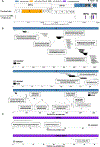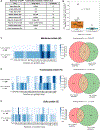The HLA-II immunopeptidome of SARS-CoV-2
- PMID: 38117652
- PMCID: PMC10860710
- DOI: 10.1016/j.celrep.2023.113596
The HLA-II immunopeptidome of SARS-CoV-2
Abstract
Targeted synthetic vaccines have the potential to transform our response to viral outbreaks, yet the design of these vaccines requires a comprehensive knowledge of viral immunogens. Here, we report severe acute respiratory syndrome coronavirus 2 (SARS-CoV-2) peptides that are naturally processed and loaded onto human leukocyte antigen-II (HLA-II) complexes in infected cells. We identify over 500 unique viral peptides from canonical proteins as well as from overlapping internal open reading frames. Most HLA-II peptides colocalize with known CD4+ T cell epitopes in coronavirus disease 2019 patients, including 2 reported immunodominant regions in the SARS-CoV-2 membrane protein. Overall, our analyses show that HLA-I and HLA-II pathways target distinct viral proteins, with the structural proteins accounting for most of the HLA-II peptidome and nonstructural and noncanonical proteins accounting for the majority of the HLA-I peptidome. These findings highlight the need for a vaccine design that incorporates multiple viral elements harboring CD4+ and CD8+ T cell epitopes to maximize vaccine effectiveness.
Keywords: CD4(+) T cell; CP: Immunology; CP: Microbiology; HLA-II; SARS-CoV-2; antigen processing and presentation; immunity; immunopeptidome; noncanonical protein; viral antigen.
Copyright © 2023 The Authors. Published by Elsevier Inc. All rights reserved.
Conflict of interest statement
Declaration of interests S.W.-G., D.-Y.C., S.S., K.R.C., N.H., S.A.C., J.G.A., M.S., and P.C.S. are named co-inventors on a patent application related to this work, filed by The Broad Institute, that is being made available in accordance with the COVID-19 technology licensing framework to maximize access to university innovations. N.H. is a founder of Neon Therapeutics (now BioNTech US), was a member of its scientific advisory board, and holds shares. N.H. is also an advisor for IFM Therapeutics. S.A.C. is a member of the scientific advisory boards of Kymera, PTM BioLabs, Seer, and PrognomIQ. J.G.A. is a past employee of Neon Therapeutics (now BioNTech US). P.C.S. is a cofounder of and consultant to Sherlock Biosciences and Delve Biosciences and a board member of Danaher Corporation and holds equity in the companies.
Figures




Update of
-
The HLA-II immunopeptidome of SARS-CoV-2.bioRxiv [Preprint]. 2023 Jun 1:2023.05.26.542482. doi: 10.1101/2023.05.26.542482. bioRxiv. 2023. Update in: Cell Rep. 2024 Jan 23;43(1):113596. doi: 10.1016/j.celrep.2023.113596. PMID: 37398281 Free PMC article. Updated. Preprint.
References
-
- Wherry EJ, and Barouch DH (2022). T cell immunity to COVID-19 vaccines. Science 377, 821–822. - PubMed
-
- Neale I, Ali M, Kronsteiner B, Longet S, Abraham P, Deeks AS, Brown A, Moore SC, Stafford L, Dobson SL, et al. (2023). CD4+ and CD8+ T Cell and Antibody Correlates of Protection against Delta Vaccine Breakthrough Infection: A Nested Case-Control Study within the PITCH Study. Preprint at medRxiv. - PMC - PubMed
-
- Sahin U, Muik A, Vogler I, Derhovanessian E, Kranz LM, Vormehr M, Quandt J, Bidmon N, Ulges A, Baum A, et al. (2021). BNT162b2 vaccine induces neutralizing antibodies and poly-specific T cells in humans. Nature 595, 572–577. - PubMed
MeSH terms
Substances
Grants and funding
LinkOut - more resources
Full Text Sources
Other Literature Sources
Medical
Molecular Biology Databases
Research Materials
Miscellaneous

